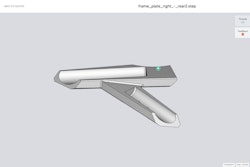What is a Point Cloud?
Using a 3D laser scanner to create an accurate representation of an industrial facility is not a new idea. With the rapid advancement of both processing and storage hardware, coupled with decreasing costs, this sort of real-world data can be leveraged by almost any facility for new construction or retrofit engineering. 3D Laser Scanning is still not a ‘one-off’ process though. You must take into account the nature of both the scanner and the output to ensure you get the full picture, in the best detail.
A laser scanner in one position records one sphere of data of the 3D space that makes up your facility. The scanner must record from multiple positions to ‘see’ the whole environment. To visualize this, think of standing in one spot with an pneumatic paint sprayer and coating everything that you can without moving your from your spot. You will find that many areas, objects, equipment, etc have little or no paint on them. In order to completely paint the area, you will have to change your position and continue spraying paint. The laser scanner is moved to multiple positions to record areas obscured by structures or equipment.
When the scanning is complete, these disparate spheres of data have to be put back together digitally to form a full point cloud. This used to be an arduous process, increasing the costs in time and labor to use laser scanning as a tool. Even though new software tools make ‘stitching’ scans together to form a full environment much more intuitive, to ensure you get the highest level of detail with the least billed hours, it’s often best to hire 3D scanning experts.
Working in a Point Cloud
Now that the individual spheres have been successfully combined into one large point cloud, it can be used in a variety of ways. All point clouds are not the same, the ‘density’ of the scan determines the detail level of the cloud. Having experienced engineers scanning the project ensure that the point cloud includes all angles needed and does not have ‘holes’ that need to be filled later.
Once you have the completed point cloud you can identify and flag key components. This may be a piece of equipment, conduit runs or a pipe that must be replaced as part of a retrofit. You can move freely through this virtual space and look at anything from any angle, position or scale. You can also perform numerous ‘edits’ to the 3D space including cutting elements out or copying 3D elements and pasting new copies of them. You can lock and unlock portions of the point cloud or color certain key areas based on various parameters. A skilled drafter or engineer can learn to work directly within a point cloud without the need for additional modeling and rendering. Ad-hoc measurements can be made of difficult locations without ever stepping foot back inside the facility.
You can also model surfaces onto a point cloud and add animations. Animation and 3D models are useful tools that make it easier for all the stakeholders in a project to quickly understand key elements. Animations are typically programmed in after a simulation is completed. Simulation is the process of modeling the steps of a project or the behavior of a certain object. Simulation is one of the key reasons to use 3D scanning and engineering within point clouds. The function of material handling equipment can be simulated to increase efficiency. The operation of certain equipment can be simulated to maximize safety. Engineering in 3D allows multiple scenarios to be played out, minimizing project cost and risk while finding optimal solutions.
How do you do it?
Working with point clouds in real time requires significant computer hardware for a smooth workflow. A strong design station, with standalone graphics processing and substantial RAM, makes point cloud work efficient. Old, outdated or underpowered computers will simply make the workflow unbearably slow. Simulation requires both substantial hardware including computers with multiple graphics processors and even then often requires a good amount of time to simulate fully.
Learn your equipment and software tools. Start with a small point cloud and learn the navigational controls. Set your fly and rotation speeds to simulate your natural cadence through a facility. Realism helps everyone on the team visualize the environment (and prevents motion sickness!). Practice placing and aligning 3D models in point clouds. Understand the limitations of your data, your software, and your skills. Work through small projects as you build into more complex engineering design needs.
Once over the hurdle of starting to work with point clouds, you will be able to quickly and easily:
- Create ‘stitched’ clouds from scans - combining multiple scans into a larger rendering.
- Add models or anchor the cloud to a design drawing.
- Model ‘clashes’ to ensure new equipment will fit as intended or project tasks requiring movement of large/critical objects can be planned step by step in advance.
Experts at 3D scanning and engineering are best for complex scanning jobs. This is because they can foresee the challenges of a project and make sure the correct areas/objects are scanned the first time and project steps are accurately simulated at each phase. Reducing project downtime through 3D scanning and project risk management in delays saves time and money while project planning makes every project phase safer and more efficient.
Jason Schwartz is a Principal at Acensium.






















